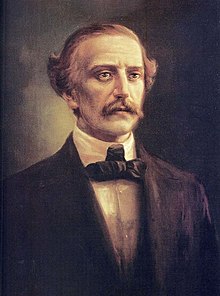Juan Pablo Duarte
| Juan Pablo Duarte | |
|---|---|
 |
|
| Born |
January 26, 1813 Santo Domingo, Captaincy General of Santo Domingo (later the Dominican Republic) |
| Died | July 15, 1876 (aged 63) Caracas, Venezuela |
| Nationality | Dominican, |
| Occupation | One of the Founding Fathers of the Dominican Republic |
| Known for | Visionary and liberal thinker |
Juan Pablo Duarte Díez (January 26, 1813 – July 15, 1876) is one of the founding fathers of the Dominican Republic. He was a visionary and liberal thinker, who along with Francisco del Rosario Sánchez and Matías Ramón Mella, is widely considered to be the architect of the Dominican Republic and its independence from Haitian rule in 1844. He would help create the political organization La Trinitaria to fight against the Haitian occupation, achieve independence, and create a self-sufficient nation.
Duarte helped inspire and finance the Dominican War of Independence, paying a heavy toll which would eventually ruin him financially. His liberal views made him a controversial figure among conservative and powerful Dominicans of the time, and he was exiled at numerous occasions after the founding of the new nation. His liberal views went against the conservative elites who sought for heavy-handed control of the nation, and wanted to maintain the traditional regionalisms of the past. Duarte had strong disagreements with the republic's first president, Pedro Santana, as Santana was a tyrannical figure. Ultimately, Duarte would spend many years away from the nation he helped shape and would die in exile, this made him a political martyr in the eyes of subsequent generations.
Duarte was born in Santo Domingo, Captaincy General of Santo Domingo during the period commonly called España Boba.
Duarte’s father was Juan José Duarte Rodríguez, a Peninsular from Vejer de la Frontera, Kingdom of Seville, Spain, and his mother was Manuela Díez Jiménez from El Seybo, Captaincy General of Santo Domingo; three of Duarte’s grandparents were Europeans. In 1802 the Duarte family migrated from Santo Domingo to Mayagüez, Puerto Rico. They were evading the unrest caused by the Haitian Revolution in the island. Many Dominican families left the island during this period.Toussaint Louverture, governor of Saint-Domingue (now Haiti), a former colony of France located on the western third of Hispaniola, arrived to the capital of Santo Domingo, located on the island’s eastern two-thirds, the previous year and proclaimed the end of slavery (although the changes were not permanent). At the time, France and Saint-Domingue (the western third of the island), were going through exhaustive social movements, namely, the French Revolution and the Haitian Revolution. In occupying the Spanish side of the island the European hating governor was using as a pretext the previous agreements between the governments of France and Spain in the Peace of Basel signed in 1795, which had given the Spanish area to France.
...
Wikipedia
